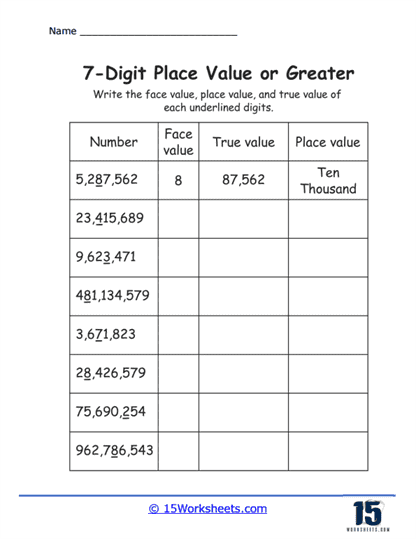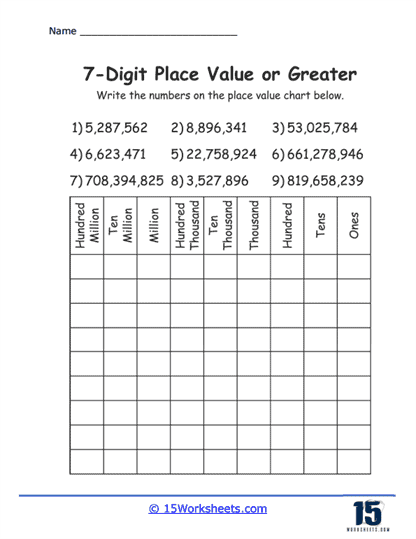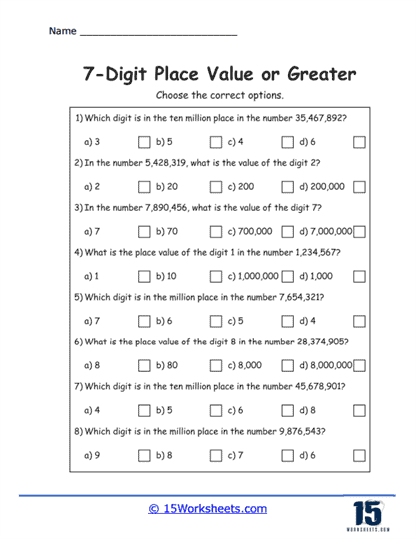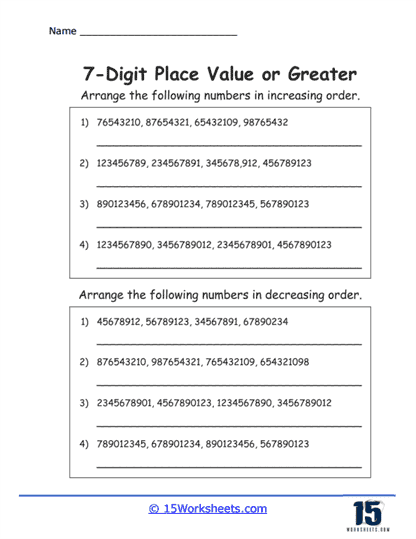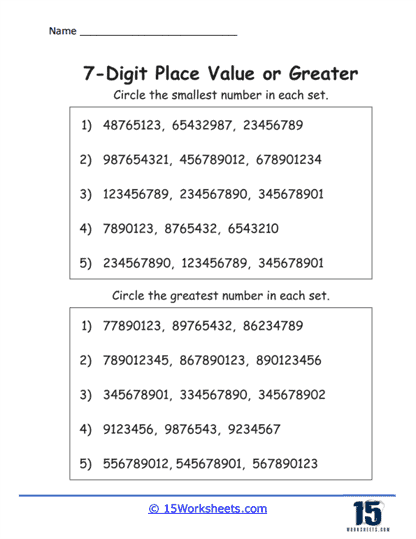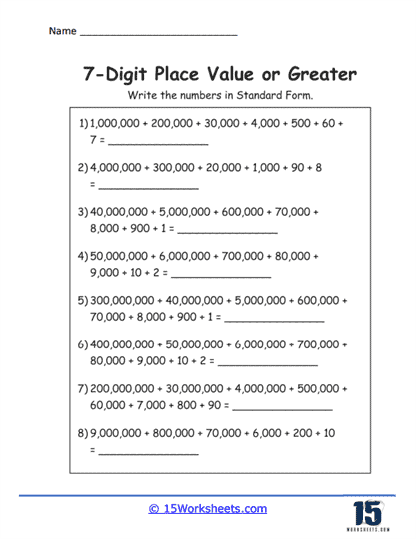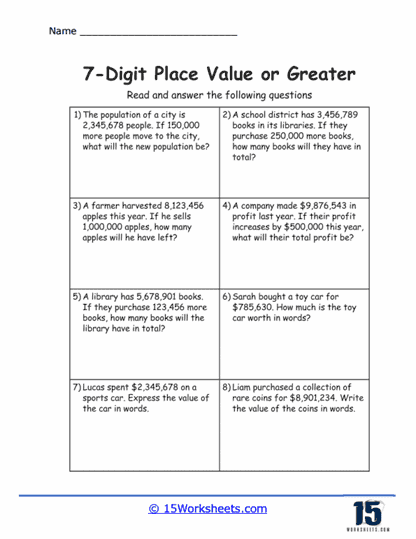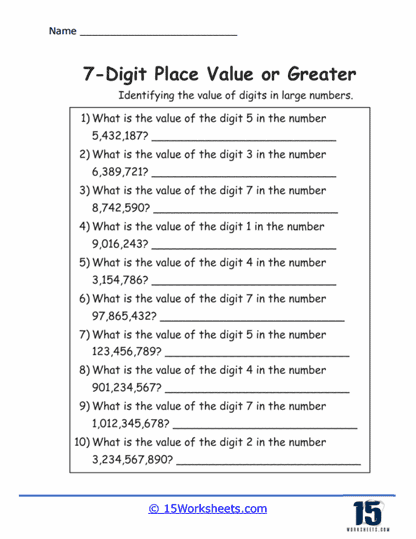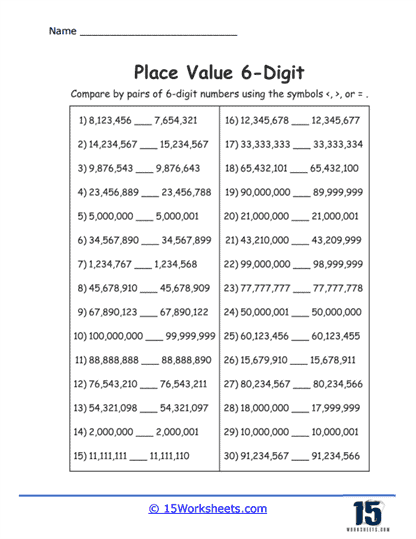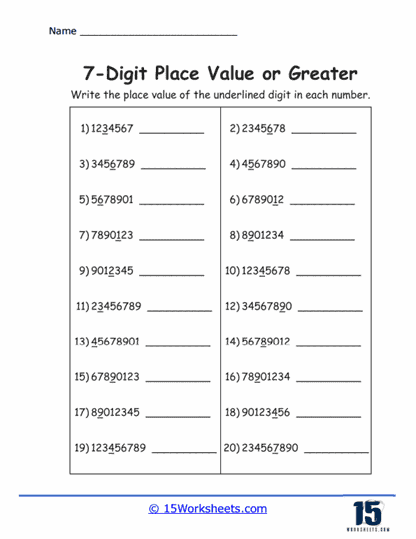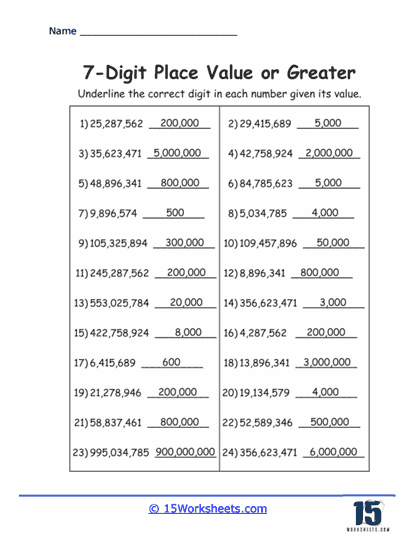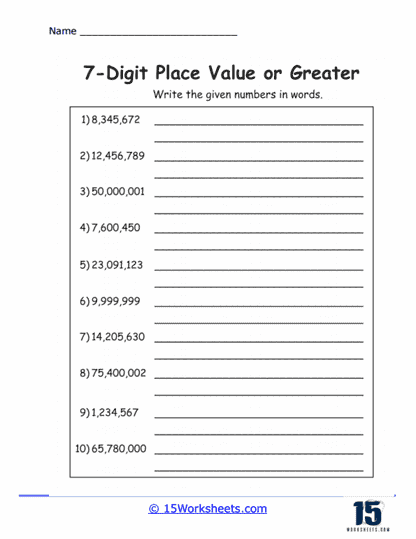7-Digit Place Value Worksheets
About These 15 Worksheets
These worksheets cater to elementary and middle school students who are developing their number sense and place value knowledge. The exercises within these worksheets not only help students recognize the value of individual digits within larger numbers but also enhance their overall numerical fluency and ability to work with large numbers in various mathematical contexts. Each worksheet type targets specific skills, reinforcing students’ understanding of place value through diverse activities.
One of the primary types of activities you would find on these worksheets is identifying and writing numbers in place value charts. These exercises ask students to place a given 7-digit or greater number into a chart that breaks down the number by place value, from the ones place all the way to the hundred million place. This activity teaches students how each digit in a number holds a different value depending on its position. For example, the digit “5” in the number 5,287,562 has a completely different value when it’s in the millions place compared to when it’s in the tens place. By breaking down these numbers into their respective places, students begin to see how large numbers are constructed and can more easily compare or manipulate them.
Another critical type of worksheet involves identifying the face value, true value, and place value of underlined digits in large numbers. Here, students are given a number with one digit underlined and are asked to determine three things – the face value of the digit (which is simply the digit itself), the true value of the digit (which depends on its place in the number), and the name of its place value (such as “Ten Thousand” or “Million”). This type of exercise deepens students’ understanding by making them think about not just the digit itself but how its position impacts its total value in the context of the number. For instance, in the number 5,287,562, the underlined digit “8” has a face value of 8, but because it is in the ten thousand place, its true value is 80,000. These worksheets help bridge the gap between rote memorization of numbers and a deeper conceptual understanding of how those numbers function.
The third type of worksheet focuses on identifying the place value of underlined digits in numbers. This activity requires students to look at a digit within a large number and determine its place value. For example, in the number 1234567, if the digit “4” is underlined, the student needs to recognize that it is in the ten thousand place. This type of exercise reinforces the concept that the value of a digit is contingent on its position in the number, helping students to think critically about the structure of numbers rather than just reading them passively.
Worksheets that ask students to compare pairs of 6-digit numbers using symbols like greater than, less than, or equal to further extend place value learning. These exercises challenge students to compare the value of numbers by examining their digits from left to right, starting with the largest place value. For instance, students might compare 3,456,789 with 3,457,689 and determine which is greater. Such tasks enhance students’ ability to quickly and accurately assess the magnitude of large numbers, a skill that is vital not just in math but in everyday situations where comparisons of large figures are necessary.
There are also real-world problem-solving exercises using place value concepts. Students are given scenarios that involve large numbers, such as comparing the populations of two countries or the revenue of two companies. These exercises require students to apply their understanding of place value in a practical context, helping them to see the relevance of what they are learning. For example, students might need to determine which company had a higher revenue based on given figures, thus applying their knowledge of comparing large numbers.
There are also worksheets that focus on identifying the value of specific digits within large numbers. These exercises are straightforward but crucial in helping students solidify their understanding of how place value works. For instance, students might be asked to find the value of the digit “5” in the number 5,432,187, which would be 5,000,000. This type of practice is essential for ensuring that students not only understand place value theoretically but can also quickly and accurately apply this understanding when working with numbers.
Worksheets that ask students to write numbers in standard form are also common in this collection. In these exercises, students are given expanded forms of numbers (e.g., 1,000,000 + 200,000 + 30,000 + 4,000 + 500 + 60 + 7) and asked to combine them into a single standard form number (1,234,567). This activity helps students understand how numbers can be decomposed and recomposed, reinforcing their understanding of place value and the hierarchical structure of the number system.
Rounding large numbers to the nearest million, ten million, or hundred million is another vital skill covered by these worksheets. Students are asked to round numbers like 216,225,784 to the nearest million. This type of exercise helps students develop their estimation skills and understand how rounding works, which is crucial for simplifying numbers and making quick mental calculations.
Worksheets that involve arranging numbers in increasing or decreasing order teach students how to order large numbers based on their place value. This activity requires students to compare each digit in the numbers to determine their correct sequence. For example, students might be given a set of numbers like 76543210, 87654321, and 65432109 and asked to arrange them from smallest to largest. This exercise not only reinforces their understanding of place value but also enhances their ability to work with sequences and patterns in numbers.

